Home
Research
Publications
Astronomy
My research is focused on seismicity that is induced in the surroundings of geothermal exploration and production, hydrocarbon extraction or deep waste water disposal. In my work, I study the elastic, poroelastic and inelastic changes of the tectonic stress field due to forced fluid flow and seismic and aseismic deformations in reservoirs. Further interests are on the tectonic stress field, borehole stability and the time-dependent behaviors in rock mechanics from the laboratory to the fault zone scale.
> Earthquake processes and induced seismicity
▷ Earthquake relocation for Oklahoma and Southern Kansas
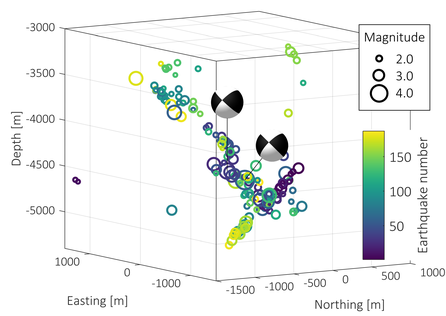 The areally wide-spread fluid injection that causes earthquakes in several regions of the United States gives us an unprecedented view on the role of fluids, the structure and conditions of stress of the Earth's crust in an area with low natural strain rate. The data that we are collecting now and in the years to come have the potential to influence the fundamentals of our field. Relocation of earthquakes highlights the role of the regional fault structure. By combining observations from the more than one hundred reactivated faults, we are able to study how these faults get reactivated, how seismicity propagates along these faults and hence which the driving mechanisms of induced seismicity in this setting are.
The areally wide-spread fluid injection that causes earthquakes in several regions of the United States gives us an unprecedented view on the role of fluids, the structure and conditions of stress of the Earth's crust in an area with low natural strain rate. The data that we are collecting now and in the years to come have the potential to influence the fundamentals of our field. Relocation of earthquakes highlights the role of the regional fault structure. By combining observations from the more than one hundred reactivated faults, we are able to study how these faults get reactivated, how seismicity propagates along these faults and hence which the driving mechanisms of induced seismicity in this setting are.
[Schoenball & Ellsworth, SRL, 2017; Schoenball & Ellsworth, JGR, 2017; Schoenball et al., TLE, 2018]
▷ Comparative analysis of natural and induced seismicity
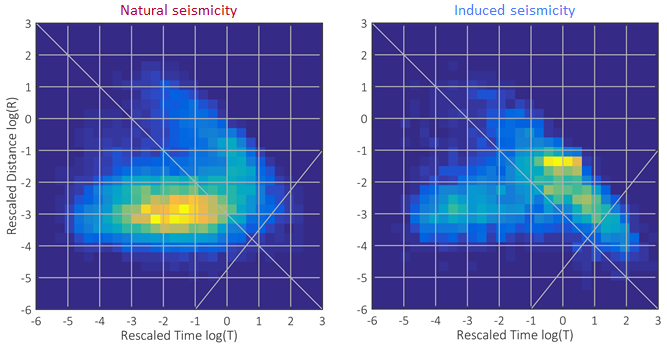 Although the driving forces between natural and induced earthquakes differ significantly, properties that can discriminate between both kinds of seismicity are elusive. By analyzing the statistical properties of nearest neighbors identified using a metric that combines location, timing and magnitude information reveals differences in the clustering behavior of natural versus induced seismicity. I demonstrated the technique using seismicity recorded below and around the Coso Geothermal Field.
Although the driving forces between natural and induced earthquakes differ significantly, properties that can discriminate between both kinds of seismicity are elusive. By analyzing the statistical properties of nearest neighbors identified using a metric that combines location, timing and magnitude information reveals differences in the clustering behavior of natural versus induced seismicity. I demonstrated the technique using seismicity recorded below and around the Coso Geothermal Field.
[Schoenball et al., GRL, 2015]
▷ Changes of the stress state in space and time
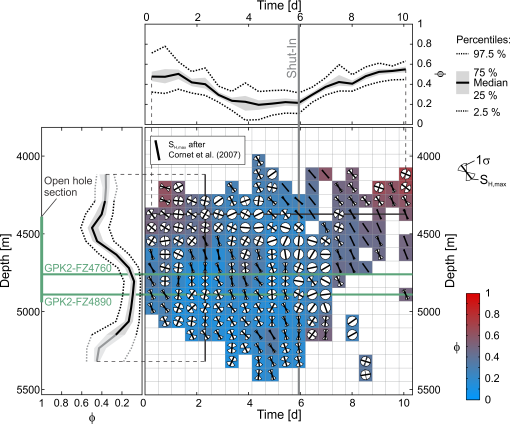 Compared to natural processes, anthropogenic perturbations of the state of stress in the Earth's crust occur on short time scales and on small spatial scales with large gradients.
Using inversions of focal mechanisms, I inferred the changes of the stress tensor causative of earthquakes induced by a massive hydraulic stimulation. Here, perturbations on the order of several megapascals are created within hours and days. Overall, the observed stress release is much greater than what is expected from the recorded seismic events indicating significant aseismic deformation. Understanding this aseismic deformation will be key to the development of soft stimulation techniques.
Compared to natural processes, anthropogenic perturbations of the state of stress in the Earth's crust occur on short time scales and on small spatial scales with large gradients.
Using inversions of focal mechanisms, I inferred the changes of the stress tensor causative of earthquakes induced by a massive hydraulic stimulation. Here, perturbations on the order of several megapascals are created within hours and days. Overall, the observed stress release is much greater than what is expected from the recorded seismic events indicating significant aseismic deformation. Understanding this aseismic deformation will be key to the development of soft stimulation techniques.
[Schoenball et al., JGR, 2012,; Schoenball et al., GRL, 2014]
> Geothermal systems
▷ Enhanced geothermal systems
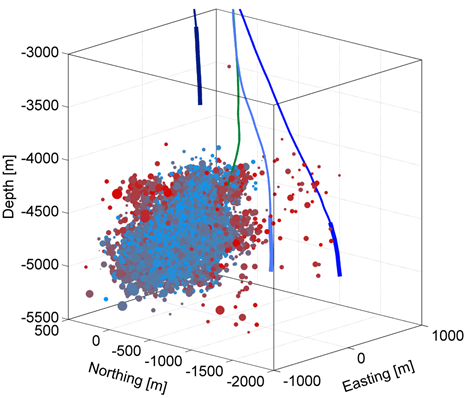 Enhanced geothermal systems have the potential to significantly contribute to our energy demand independent of a particularly favorable geological setting. In my research, I study the pilot EGS at Soultz-sous-Foręts, France. Specifically, I analyze the hydromechanical response to massive hydraulic stimulation that is conducted to enhance the permeability of the underground. Induced earthquakes illuminate the structure of such systems and may reveal correlations with mechanical properties of the host rock, its fault structure and other geological features.
Enhanced geothermal systems have the potential to significantly contribute to our energy demand independent of a particularly favorable geological setting. In my research, I study the pilot EGS at Soultz-sous-Foręts, France. Specifically, I analyze the hydromechanical response to massive hydraulic stimulation that is conducted to enhance the permeability of the underground. Induced earthquakes illuminate the structure of such systems and may reveal correlations with mechanical properties of the host rock, its fault structure and other geological features.
[Sabin et al., SGW, 2016; Schoenball et al., GRL, 2014; Schoenball et al., JGR, 2012; Schoenball & Kohl, GRC Trans., 2013]
▷ Hydrothermal systems
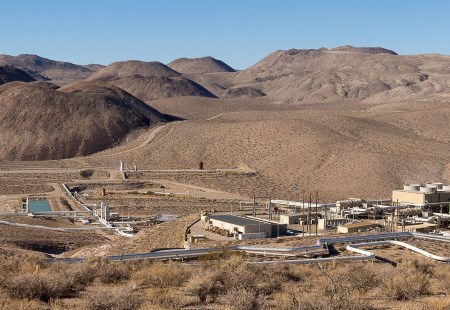 The vast majority of operational geothermal fields are in hydrothermal systems such as the Coso Geothermal Field. I try to improve our understanding of these systems, their structure and the processes that occur naturally or accompany the production operations. My tools are the analysis of seismicity patterns in time and space, both of natural and induced events and analysis of the stress field using earthquake focal mechanism data and stress indicators identified in borehole image logs.
The vast majority of operational geothermal fields are in hydrothermal systems such as the Coso Geothermal Field. I try to improve our understanding of these systems, their structure and the processes that occur naturally or accompany the production operations. My tools are the analysis of seismicity patterns in time and space, both of natural and induced events and analysis of the stress field using earthquake focal mechanism data and stress indicators identified in borehole image logs.
[Schoenball et al., SGW, 2016, Schoenball et al., SGW, 2015; Schoenball et al., GRL, 2015]
> Borehole geomechanics
▷ Stress determination from deviated wells
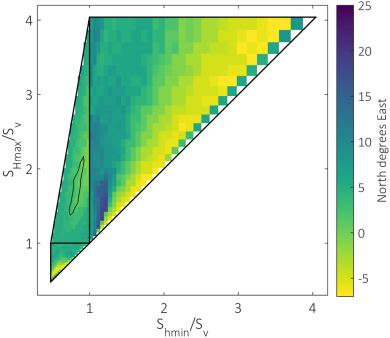 In standard wellbore analysis of stress indicators, well sections with deviations in excess of about 10° are discarded. For strongly inclined well trajectories, which are more and more important, the location of stress indicators along the wellbore wall are no longer directly related to the orientation of the principal stresses in a geographic coordinate system. Instead, the problem gets non-unique and highly non-linear. In many cases, careful analysis of such wells can still yield information on the orientation of principal stresses and may even constrain the stress regime. Hence, being able to use these wells for stress determination has to potential to substantially improve stress estimates.
In standard wellbore analysis of stress indicators, well sections with deviations in excess of about 10° are discarded. For strongly inclined well trajectories, which are more and more important, the location of stress indicators along the wellbore wall are no longer directly related to the orientation of the principal stresses in a geographic coordinate system. Instead, the problem gets non-unique and highly non-linear. In many cases, careful analysis of such wells can still yield information on the orientation of principal stresses and may even constrain the stress regime. Hence, being able to use these wells for stress determination has to potential to substantially improve stress estimates.
[Schoenball et al. , SGW, 2016]
▷ Mechanical heterogeneity of the subsurface
 High resolution analysis of wellbore image logs for stress indicators reveals variation of the stress field on the meter scale. For example, we have shown that the variation of breakout orientation can be linked to the occurrence of and intersection with pre-existing fractures. Quantifying the magnitude and extent of these mechanical heterogeneities of the crust will be important for the stimulation of reservoirs while implementing enhanced geothermal systems or for deep waste disposal in crystalline rocks.
High resolution analysis of wellbore image logs for stress indicators reveals variation of the stress field on the meter scale. For example, we have shown that the variation of breakout orientation can be linked to the occurrence of and intersection with pre-existing fractures. Quantifying the magnitude and extent of these mechanical heterogeneities of the crust will be important for the stimulation of reservoirs while implementing enhanced geothermal systems or for deep waste disposal in crystalline rocks.
[Sahara et al., IJRMMS, 2014]
▷ Evolution of borehole breakouts
 Quantitative analysis of borehole breakout dimensions has been used to infer stress magnitudes provided that the strength of the host rock is known. Using plastic constitutive laws, we analyze the evolution of borehole breakouts and their resulting dimensions under varying stress conditions. Our workflow has been successfully tested in simple geomaterials such as sandstone. Using our plastic model, we can predict the size of borehole breakouts that will develop under a certain stress condition. More complex behaviors encountered in other rock types require further numerical and experimental analyses.
Quantitative analysis of borehole breakout dimensions has been used to infer stress magnitudes provided that the strength of the host rock is known. Using plastic constitutive laws, we analyze the evolution of borehole breakouts and their resulting dimensions under varying stress conditions. Our workflow has been successfully tested in simple geomaterials such as sandstone. Using our plastic model, we can predict the size of borehole breakouts that will develop under a certain stress condition. More complex behaviors encountered in other rock types require further numerical and experimental analyses.
[Schoenball et al., IJRMMS, 2014, Sahara et al., 2017]
> Hydromechanics
▷ Poroelastic phenomena of fluid injection and extraction
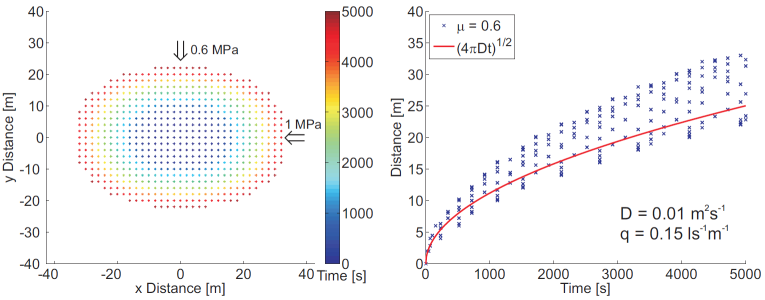 The mechanical coupling of porous media under stress to fluid flow bears a number of interesting effects. For example, fluid extraction can lead to increases of the failure stress or ceasing pumping can lead to local increases of pore fluid pressure. In my research I analyze these effects and their influence on the implementation and operation of geothermal fields and other fields involving underground fluid flow. In my earlier work, we have shown that poroelastic coupling introduces a geometric anisotropy because of the differential changes to the total principal stress components, leading to a preferential expansion of induced seismicity along the SHMax direction.
The mechanical coupling of porous media under stress to fluid flow bears a number of interesting effects. For example, fluid extraction can lead to increases of the failure stress or ceasing pumping can lead to local increases of pore fluid pressure. In my research I analyze these effects and their influence on the implementation and operation of geothermal fields and other fields involving underground fluid flow. In my earlier work, we have shown that poroelastic coupling introduces a geometric anisotropy because of the differential changes to the total principal stress components, leading to a preferential expansion of induced seismicity along the SHMax direction.
[Schoenball et al. , GJI, 2010]
▷ Fluid flow in rough fractures
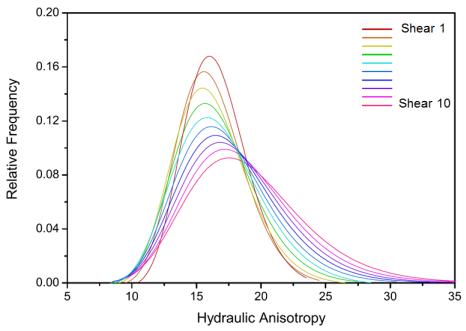 Fluid flow in rock fractures is usually approximated in first order using the cubic law for fluid flow between parallel plates. However, natural fractures have a rough surface and hence variable aperture distribution. This will lead to tortuous fluid flow paths and flow channeling. Additionally, shearing of rough surfaces will introduce a geometric and hydraulic anisotropy which is an important parameter for the creation of fluid pathways and enhances the channeling effect.
Fluid flow in rock fractures is usually approximated in first order using the cubic law for fluid flow between parallel plates. However, natural fractures have a rough surface and hence variable aperture distribution. This will lead to tortuous fluid flow paths and flow channeling. Additionally, shearing of rough surfaces will introduce a geometric and hydraulic anisotropy which is an important parameter for the creation of fluid pathways and enhances the channeling effect.
[Schoenball et al. , EGC, 2013]